Financial Skills for Entrepreneurs
VerifiedAdded on 2023/01/09
|12
|1700
|42
AI Summary
This document provides insights into the financial skills required for entrepreneurs. It covers topics such as financial analysis, budgets, income statements, balance sheets, and cash flow management. The report also includes case studies and practical examples.
Contribute Materials
Your contribution can guide someone’s learning journey. Share your
documents today.

FINANCIAL SKILLS FOR
ENTREPRENEURS
ENTREPRENEURS
Secure Best Marks with AI Grader
Need help grading? Try our AI Grader for instant feedback on your assignments.
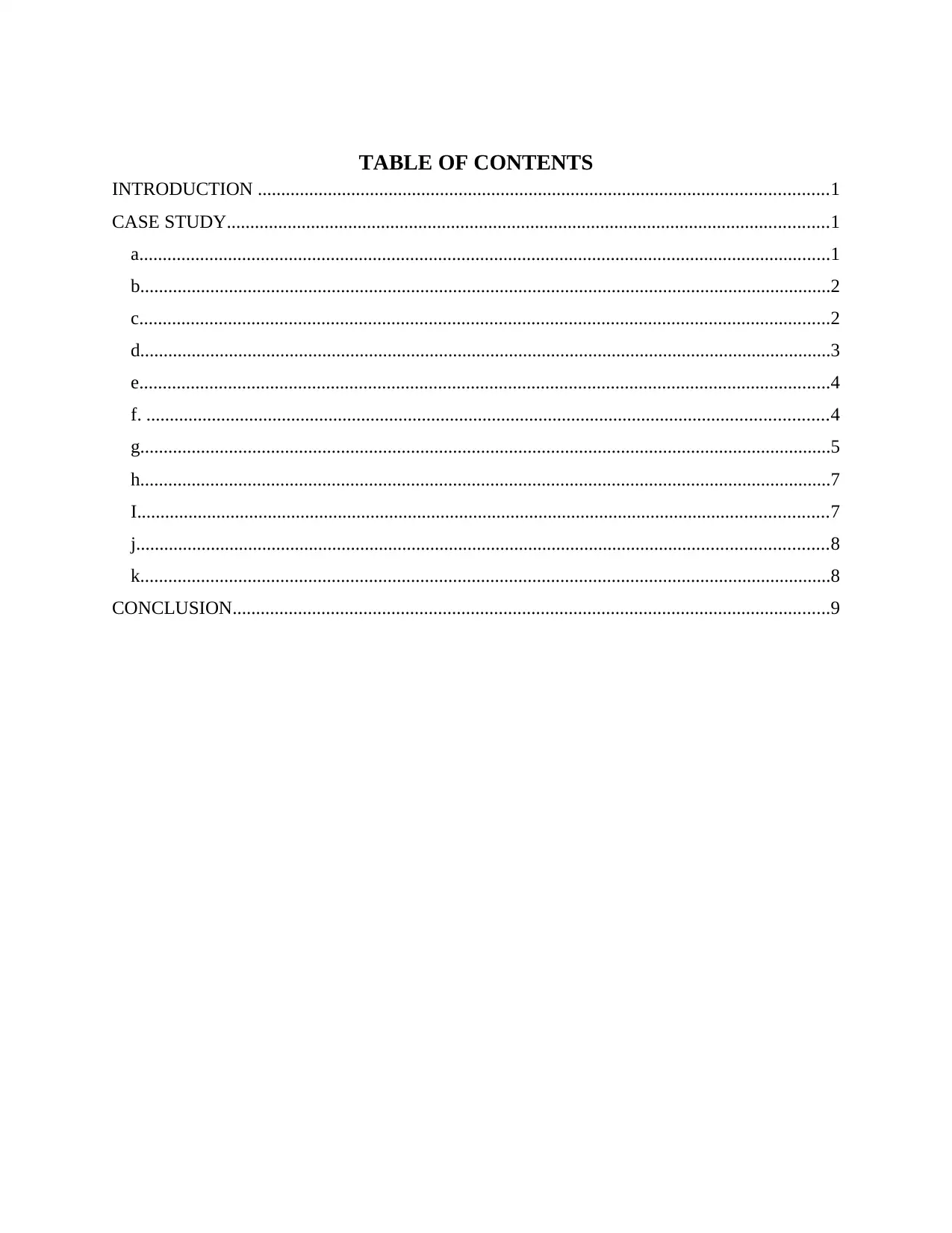
TABLE OF CONTENTS
INTRODUCTION ..........................................................................................................................1
CASE STUDY.................................................................................................................................1
a....................................................................................................................................................1
b....................................................................................................................................................2
c....................................................................................................................................................2
d....................................................................................................................................................3
e....................................................................................................................................................4
f. ..................................................................................................................................................4
g....................................................................................................................................................5
h....................................................................................................................................................7
I....................................................................................................................................................7
j....................................................................................................................................................8
k....................................................................................................................................................8
CONCLUSION................................................................................................................................9
INTRODUCTION ..........................................................................................................................1
CASE STUDY.................................................................................................................................1
a....................................................................................................................................................1
b....................................................................................................................................................2
c....................................................................................................................................................2
d....................................................................................................................................................3
e....................................................................................................................................................4
f. ..................................................................................................................................................4
g....................................................................................................................................................5
h....................................................................................................................................................7
I....................................................................................................................................................7
j....................................................................................................................................................8
k....................................................................................................................................................8
CONCLUSION................................................................................................................................9
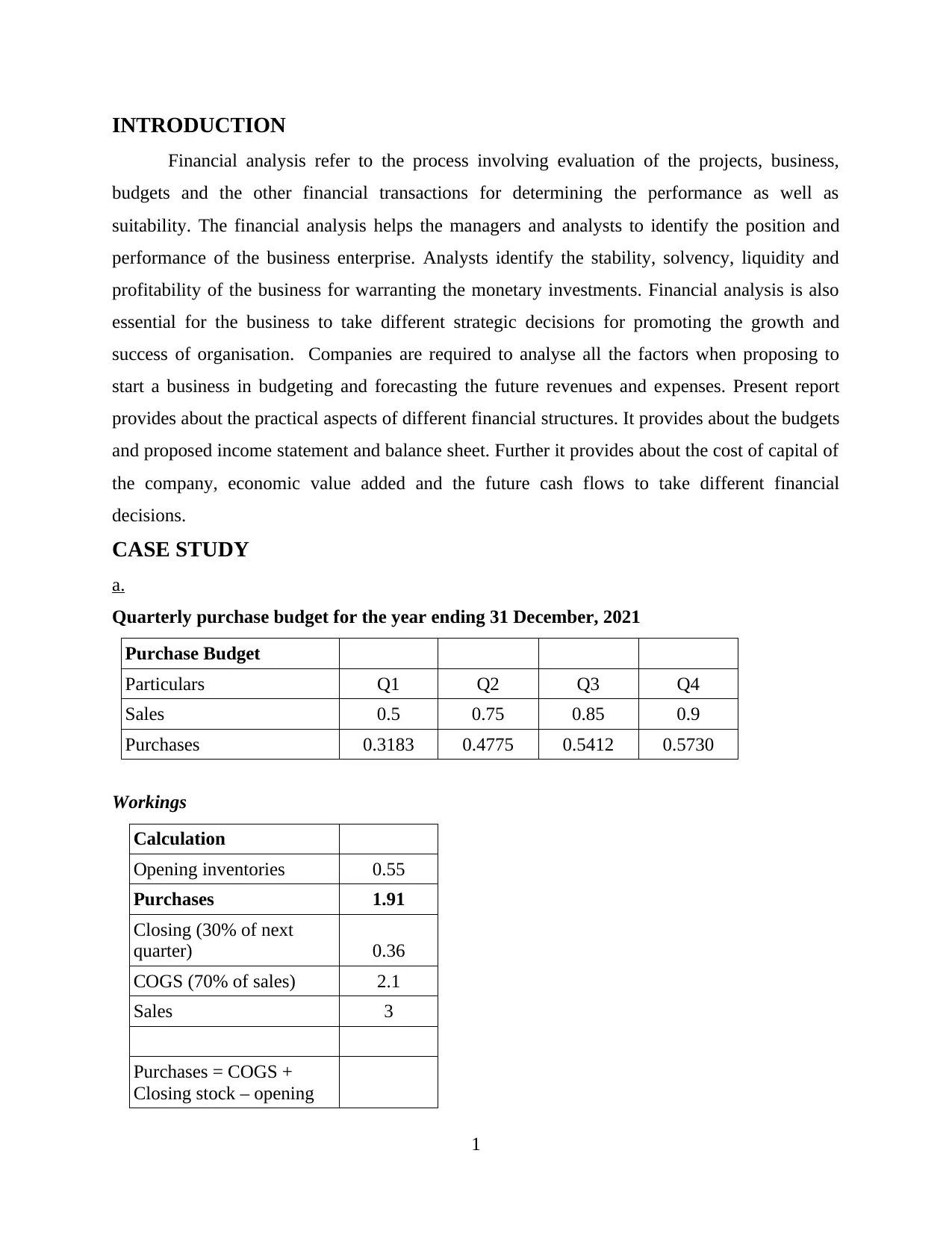
INTRODUCTION
Financial analysis refer to the process involving evaluation of the projects, business,
budgets and the other financial transactions for determining the performance as well as
suitability. The financial analysis helps the managers and analysts to identify the position and
performance of the business enterprise. Analysts identify the stability, solvency, liquidity and
profitability of the business for warranting the monetary investments. Financial analysis is also
essential for the business to take different strategic decisions for promoting the growth and
success of organisation. Companies are required to analyse all the factors when proposing to
start a business in budgeting and forecasting the future revenues and expenses. Present report
provides about the practical aspects of different financial structures. It provides about the budgets
and proposed income statement and balance sheet. Further it provides about the cost of capital of
the company, economic value added and the future cash flows to take different financial
decisions.
CASE STUDY
a.
Quarterly purchase budget for the year ending 31 December, 2021
Purchase Budget
Particulars Q1 Q2 Q3 Q4
Sales 0.5 0.75 0.85 0.9
Purchases 0.3183 0.4775 0.5412 0.5730
Workings
Calculation
Opening inventories 0.55
Purchases 1.91
Closing (30% of next
quarter) 0.36
COGS (70% of sales) 2.1
Sales 3
Purchases = COGS +
Closing stock – opening
1
Financial analysis refer to the process involving evaluation of the projects, business,
budgets and the other financial transactions for determining the performance as well as
suitability. The financial analysis helps the managers and analysts to identify the position and
performance of the business enterprise. Analysts identify the stability, solvency, liquidity and
profitability of the business for warranting the monetary investments. Financial analysis is also
essential for the business to take different strategic decisions for promoting the growth and
success of organisation. Companies are required to analyse all the factors when proposing to
start a business in budgeting and forecasting the future revenues and expenses. Present report
provides about the practical aspects of different financial structures. It provides about the budgets
and proposed income statement and balance sheet. Further it provides about the cost of capital of
the company, economic value added and the future cash flows to take different financial
decisions.
CASE STUDY
a.
Quarterly purchase budget for the year ending 31 December, 2021
Purchase Budget
Particulars Q1 Q2 Q3 Q4
Sales 0.5 0.75 0.85 0.9
Purchases 0.3183 0.4775 0.5412 0.5730
Workings
Calculation
Opening inventories 0.55
Purchases 1.91
Closing (30% of next
quarter) 0.36
COGS (70% of sales) 2.1
Sales 3
Purchases = COGS +
Closing stock – opening
1

stock
b.
Quarterly general, administration and the selling budget for the year ending 31 December,
2021
General and administration budget
Particulars Q1 Q2 Q3 Q4
Sales 0.5 0.75 0.85 0.9
Cash expenses 0.05 0.075 0.085 0.09
Depreciation 0.01 0.01 0.01 0.01
Interest on outstanding
lease 0.00175 0.00175 0.00175 0.00175
Capital lease instalments 0.02 0.02 0.02 0.02
Total 0.08175 0.10675 0.11675 0.12175
c.
Cash budget for the year ending 31 December, 2021
Cash Budget
Particulars Q1 Q2 Q3 Q4
Inflows
Cash collections 0.47 0.5 0.75 0.85
Total 0.47 0.5 0.75 0.85
Outflows
Purchases 60% 0.3 0.45 0.51 0.54
Purchases 40% 0.17 0.2 0.3 0.34
General and administration
expenses 0.05 0.075 0.085 0.09
2
b.
Quarterly general, administration and the selling budget for the year ending 31 December,
2021
General and administration budget
Particulars Q1 Q2 Q3 Q4
Sales 0.5 0.75 0.85 0.9
Cash expenses 0.05 0.075 0.085 0.09
Depreciation 0.01 0.01 0.01 0.01
Interest on outstanding
lease 0.00175 0.00175 0.00175 0.00175
Capital lease instalments 0.02 0.02 0.02 0.02
Total 0.08175 0.10675 0.11675 0.12175
c.
Cash budget for the year ending 31 December, 2021
Cash Budget
Particulars Q1 Q2 Q3 Q4
Inflows
Cash collections 0.47 0.5 0.75 0.85
Total 0.47 0.5 0.75 0.85
Outflows
Purchases 60% 0.3 0.45 0.51 0.54
Purchases 40% 0.17 0.2 0.3 0.34
General and administration
expenses 0.05 0.075 0.085 0.09
2
Secure Best Marks with AI Grader
Need help grading? Try our AI Grader for instant feedback on your assignments.
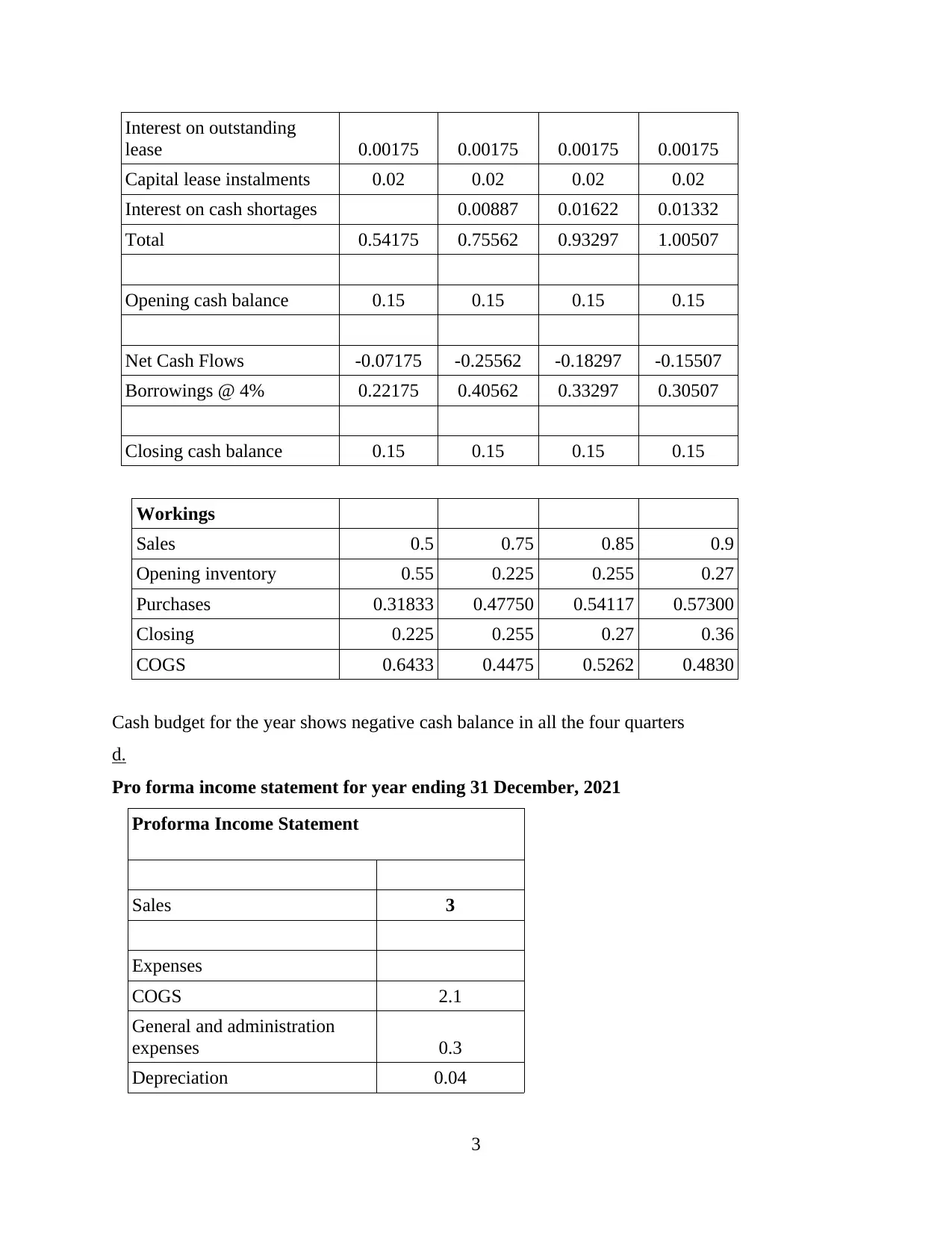
Interest on outstanding
lease 0.00175 0.00175 0.00175 0.00175
Capital lease instalments 0.02 0.02 0.02 0.02
Interest on cash shortages 0.00887 0.01622 0.01332
Total 0.54175 0.75562 0.93297 1.00507
Opening cash balance 0.15 0.15 0.15 0.15
Net Cash Flows -0.07175 -0.25562 -0.18297 -0.15507
Borrowings @ 4% 0.22175 0.40562 0.33297 0.30507
Closing cash balance 0.15 0.15 0.15 0.15
Workings
Sales 0.5 0.75 0.85 0.9
Opening inventory 0.55 0.225 0.255 0.27
Purchases 0.31833 0.47750 0.54117 0.57300
Closing 0.225 0.255 0.27 0.36
COGS 0.6433 0.4475 0.5262 0.4830
Cash budget for the year shows negative cash balance in all the four quarters
d.
Pro forma income statement for year ending 31 December, 2021
Proforma Income Statement
Sales 3
Expenses
COGS 2.1
General and administration
expenses 0.3
Depreciation 0.04
3
lease 0.00175 0.00175 0.00175 0.00175
Capital lease instalments 0.02 0.02 0.02 0.02
Interest on cash shortages 0.00887 0.01622 0.01332
Total 0.54175 0.75562 0.93297 1.00507
Opening cash balance 0.15 0.15 0.15 0.15
Net Cash Flows -0.07175 -0.25562 -0.18297 -0.15507
Borrowings @ 4% 0.22175 0.40562 0.33297 0.30507
Closing cash balance 0.15 0.15 0.15 0.15
Workings
Sales 0.5 0.75 0.85 0.9
Opening inventory 0.55 0.225 0.255 0.27
Purchases 0.31833 0.47750 0.54117 0.57300
Closing 0.225 0.255 0.27 0.36
COGS 0.6433 0.4475 0.5262 0.4830
Cash budget for the year shows negative cash balance in all the four quarters
d.
Pro forma income statement for year ending 31 December, 2021
Proforma Income Statement
Sales 3
Expenses
COGS 2.1
General and administration
expenses 0.3
Depreciation 0.04
3

Interest on outstanding lease 0.007
Capital lease instalments 0.08
Income before tax 0.473
Tax@40% 0.1892
Income after tax 0.2838
e.
Proforma balance sheet for year ending 31 December, 2021
Pro forma Balance
Sheet
Assets Amount Liabilities & Equity Amount
Cash 0.15 Accounts Payable 0.36
Accounts Receivable 0.9
Capital Lease
Liability 0.06
Inventories 0.36 Total Liabilities 0.42
Net Fixed Assets 0.1 Equity 1.09
Total Assets 1.51
Total liabilities &
equity 1.51
f.
Need of bank borrowings on the basis of projections made in cash budget
1. Company requires bank borrowings for meeting the needs for additional cash
requirements. It is essential for running the operations of business successfully. In the
present case Alma.com will be requiring money for carrying out the business operations.
From the cash budget prepared above it could be analysed that the cash available with the
company is not sufficient for meeting the requirements of business. Company will be
required to borrow funds from the bank for running the operations as the cash budget
shows that the cash will go negative.
2. It has to borrow funds through bank borrowings at rate of 4% line of credit to run the
business operations smoothly. The funds will be borrowed by the company from the first
quarter onwards. It could be analysed from the cash budget that the cash flows are
4
Capital lease instalments 0.08
Income before tax 0.473
Tax@40% 0.1892
Income after tax 0.2838
e.
Proforma balance sheet for year ending 31 December, 2021
Pro forma Balance
Sheet
Assets Amount Liabilities & Equity Amount
Cash 0.15 Accounts Payable 0.36
Accounts Receivable 0.9
Capital Lease
Liability 0.06
Inventories 0.36 Total Liabilities 0.42
Net Fixed Assets 0.1 Equity 1.09
Total Assets 1.51
Total liabilities &
equity 1.51
f.
Need of bank borrowings on the basis of projections made in cash budget
1. Company requires bank borrowings for meeting the needs for additional cash
requirements. It is essential for running the operations of business successfully. In the
present case Alma.com will be requiring money for carrying out the business operations.
From the cash budget prepared above it could be analysed that the cash available with the
company is not sufficient for meeting the requirements of business. Company will be
required to borrow funds from the bank for running the operations as the cash budget
shows that the cash will go negative.
2. It has to borrow funds through bank borrowings at rate of 4% line of credit to run the
business operations smoothly. The funds will be borrowed by the company from the first
quarter onwards. It could be analysed from the cash budget that the cash flows are
4

negative from quarter one onwards and is negative throughout the year. The negative
cash flows shows the company is not having cash funds for to carry out the organisational
functions of business. Cash flows are negative in the initial years as it has not earned
enough revenues from the sales. It is required to increase the sales by implementing new
strategies in the market. It is very essential for the business to manage the cash cycle so
that it is having positive cash during the year. It has to analyse the sources of cash and
cash outflows and areas where costs could be controlled by the company. Without having
adequate cash flows companies cannot run the operations of business without
interruptions. Cash budget helps the business to identify the cash needs and make
arrangements for the fund at earlier stage. There are various sources of funds from which
most optimum source is selected with least cost.
g.
Analysis of cash cycle for the year ending 31 December, 2021
Cash Conversion cycle
Days Inventory
outstanding (Average Inventory / COGS)*365
(0.55+0.36 / 2.1)*365
15.817
Days Sales
outstanding
(Average accounts Receivable / Total Credit
Sales)*365
(0.47+0.9 / 3)*365
16.67
Days Payable
outstanding (Average Accounts payable / COGS)*365
(0.17+0.36 / 2.1)*365
9.212
Cash Conversion
cycle DIO + DSO – DPO
23.273
5
cash flows shows the company is not having cash funds for to carry out the organisational
functions of business. Cash flows are negative in the initial years as it has not earned
enough revenues from the sales. It is required to increase the sales by implementing new
strategies in the market. It is very essential for the business to manage the cash cycle so
that it is having positive cash during the year. It has to analyse the sources of cash and
cash outflows and areas where costs could be controlled by the company. Without having
adequate cash flows companies cannot run the operations of business without
interruptions. Cash budget helps the business to identify the cash needs and make
arrangements for the fund at earlier stage. There are various sources of funds from which
most optimum source is selected with least cost.
g.
Analysis of cash cycle for the year ending 31 December, 2021
Cash Conversion cycle
Days Inventory
outstanding (Average Inventory / COGS)*365
(0.55+0.36 / 2.1)*365
15.817
Days Sales
outstanding
(Average accounts Receivable / Total Credit
Sales)*365
(0.47+0.9 / 3)*365
16.67
Days Payable
outstanding (Average Accounts payable / COGS)*365
(0.17+0.36 / 2.1)*365
9.212
Cash Conversion
cycle DIO + DSO – DPO
23.273
5
Paraphrase This Document
Need a fresh take? Get an instant paraphrase of this document with our AI Paraphraser
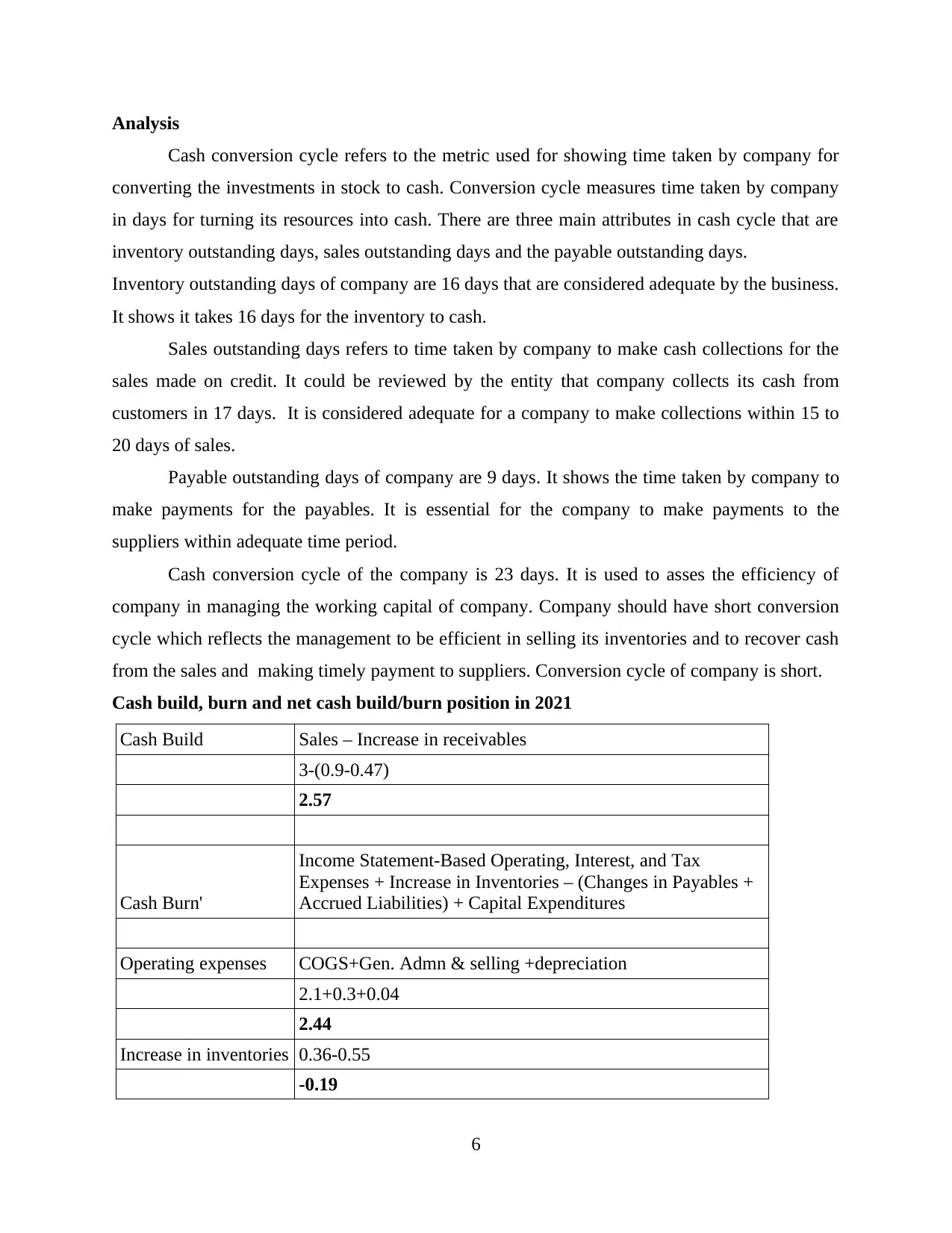
Analysis
Cash conversion cycle refers to the metric used for showing time taken by company for
converting the investments in stock to cash. Conversion cycle measures time taken by company
in days for turning its resources into cash. There are three main attributes in cash cycle that are
inventory outstanding days, sales outstanding days and the payable outstanding days.
Inventory outstanding days of company are 16 days that are considered adequate by the business.
It shows it takes 16 days for the inventory to cash.
Sales outstanding days refers to time taken by company to make cash collections for the
sales made on credit. It could be reviewed by the entity that company collects its cash from
customers in 17 days. It is considered adequate for a company to make collections within 15 to
20 days of sales.
Payable outstanding days of company are 9 days. It shows the time taken by company to
make payments for the payables. It is essential for the company to make payments to the
suppliers within adequate time period.
Cash conversion cycle of the company is 23 days. It is used to asses the efficiency of
company in managing the working capital of company. Company should have short conversion
cycle which reflects the management to be efficient in selling its inventories and to recover cash
from the sales and making timely payment to suppliers. Conversion cycle of company is short.
Cash build, burn and net cash build/burn position in 2021
Cash Build Sales – Increase in receivables
3-(0.9-0.47)
2.57
Cash Burn'
Income Statement-Based Operating, Interest, and Tax
Expenses + Increase in Inventories – (Changes in Payables +
Accrued Liabilities) + Capital Expenditures
Operating expenses COGS+Gen. Admn & selling +depreciation
2.1+0.3+0.04
2.44
Increase in inventories 0.36-0.55
-0.19
6
Cash conversion cycle refers to the metric used for showing time taken by company for
converting the investments in stock to cash. Conversion cycle measures time taken by company
in days for turning its resources into cash. There are three main attributes in cash cycle that are
inventory outstanding days, sales outstanding days and the payable outstanding days.
Inventory outstanding days of company are 16 days that are considered adequate by the business.
It shows it takes 16 days for the inventory to cash.
Sales outstanding days refers to time taken by company to make cash collections for the
sales made on credit. It could be reviewed by the entity that company collects its cash from
customers in 17 days. It is considered adequate for a company to make collections within 15 to
20 days of sales.
Payable outstanding days of company are 9 days. It shows the time taken by company to
make payments for the payables. It is essential for the company to make payments to the
suppliers within adequate time period.
Cash conversion cycle of the company is 23 days. It is used to asses the efficiency of
company in managing the working capital of company. Company should have short conversion
cycle which reflects the management to be efficient in selling its inventories and to recover cash
from the sales and making timely payment to suppliers. Conversion cycle of company is short.
Cash build, burn and net cash build/burn position in 2021
Cash Build Sales – Increase in receivables
3-(0.9-0.47)
2.57
Cash Burn'
Income Statement-Based Operating, Interest, and Tax
Expenses + Increase in Inventories – (Changes in Payables +
Accrued Liabilities) + Capital Expenditures
Operating expenses COGS+Gen. Admn & selling +depreciation
2.1+0.3+0.04
2.44
Increase in inventories 0.36-0.55
-0.19
6
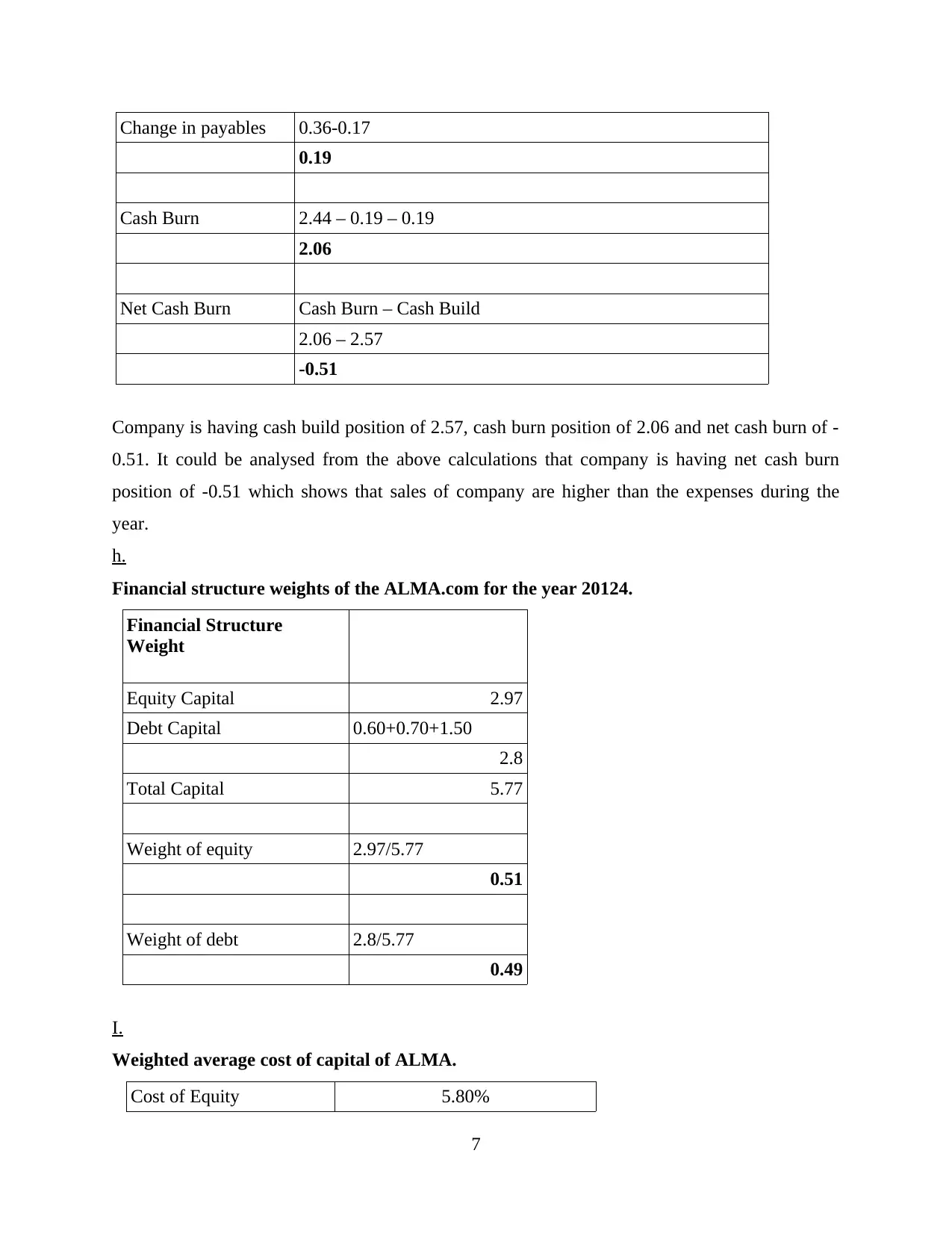
Change in payables 0.36-0.17
0.19
Cash Burn 2.44 – 0.19 – 0.19
2.06
Net Cash Burn Cash Burn – Cash Build
2.06 – 2.57
-0.51
Company is having cash build position of 2.57, cash burn position of 2.06 and net cash burn of -
0.51. It could be analysed from the above calculations that company is having net cash burn
position of -0.51 which shows that sales of company are higher than the expenses during the
year.
h.
Financial structure weights of the ALMA.com for the year 20124.
Financial Structure
Weight
Equity Capital 2.97
Debt Capital 0.60+0.70+1.50
2.8
Total Capital 5.77
Weight of equity 2.97/5.77
0.51
Weight of debt 2.8/5.77
0.49
I.
Weighted average cost of capital of ALMA.
Cost of Equity 5.80%
7
0.19
Cash Burn 2.44 – 0.19 – 0.19
2.06
Net Cash Burn Cash Burn – Cash Build
2.06 – 2.57
-0.51
Company is having cash build position of 2.57, cash burn position of 2.06 and net cash burn of -
0.51. It could be analysed from the above calculations that company is having net cash burn
position of -0.51 which shows that sales of company are higher than the expenses during the
year.
h.
Financial structure weights of the ALMA.com for the year 20124.
Financial Structure
Weight
Equity Capital 2.97
Debt Capital 0.60+0.70+1.50
2.8
Total Capital 5.77
Weight of equity 2.97/5.77
0.51
Weight of debt 2.8/5.77
0.49
I.
Weighted average cost of capital of ALMA.
Cost of Equity 5.80%
7
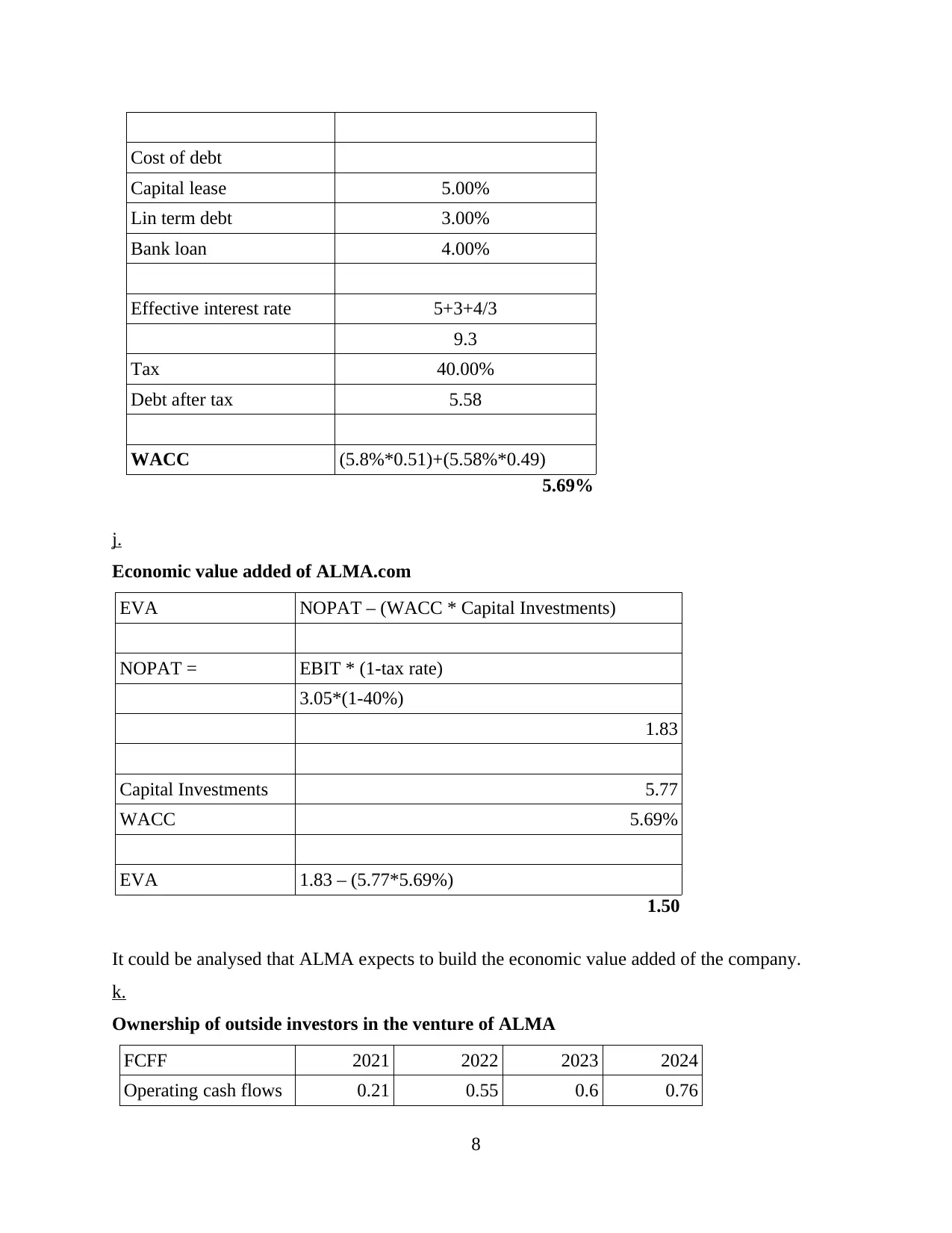
Cost of debt
Capital lease 5.00%
Lin term debt 3.00%
Bank loan 4.00%
Effective interest rate 5+3+4/3
9.3
Tax 40.00%
Debt after tax 5.58
WACC (5.8%*0.51)+(5.58%*0.49)
5.69%
j.
Economic value added of ALMA.com
EVA NOPAT – (WACC * Capital Investments)
NOPAT = EBIT * (1-tax rate)
3.05*(1-40%)
1.83
Capital Investments 5.77
WACC 5.69%
EVA 1.83 – (5.77*5.69%)
1.50
It could be analysed that ALMA expects to build the economic value added of the company.
k.
Ownership of outside investors in the venture of ALMA
FCFF 2021 2022 2023 2024
Operating cash flows 0.21 0.55 0.6 0.76
8
Capital lease 5.00%
Lin term debt 3.00%
Bank loan 4.00%
Effective interest rate 5+3+4/3
9.3
Tax 40.00%
Debt after tax 5.58
WACC (5.8%*0.51)+(5.58%*0.49)
5.69%
j.
Economic value added of ALMA.com
EVA NOPAT – (WACC * Capital Investments)
NOPAT = EBIT * (1-tax rate)
3.05*(1-40%)
1.83
Capital Investments 5.77
WACC 5.69%
EVA 1.83 – (5.77*5.69%)
1.50
It could be analysed that ALMA expects to build the economic value added of the company.
k.
Ownership of outside investors in the venture of ALMA
FCFF 2021 2022 2023 2024
Operating cash flows 0.21 0.55 0.6 0.76
8
Secure Best Marks with AI Grader
Need help grading? Try our AI Grader for instant feedback on your assignments.

PV factor @4% 0.962 0.943 0.889 0.855
PV of Cash Fllows 0.20202 0.51865 0.5334 0.6498
Sum of cash Flows 1.90387
FCFF5 0.76 *(1.01)
(0.0569 – 0.01)
FCFF 0.1637
Total Cash flow 1.90387+0.1637
2.068
Ownership in
investments 2.068/3
68.92%
CONCLUSION
It could be analysed from the above report that financial analysis is an essential part of
the business. It enables the company to make effective evaluation of the different options and
strategies of the business. All the decisions regarding the business are taken after properly
analysing all the factors and their outcomes in the business.
9
PV of Cash Fllows 0.20202 0.51865 0.5334 0.6498
Sum of cash Flows 1.90387
FCFF5 0.76 *(1.01)
(0.0569 – 0.01)
FCFF 0.1637
Total Cash flow 1.90387+0.1637
2.068
Ownership in
investments 2.068/3
68.92%
CONCLUSION
It could be analysed from the above report that financial analysis is an essential part of
the business. It enables the company to make effective evaluation of the different options and
strategies of the business. All the decisions regarding the business are taken after properly
analysing all the factors and their outcomes in the business.
9

10
1 out of 12
Your All-in-One AI-Powered Toolkit for Academic Success.
+13062052269
info@desklib.com
Available 24*7 on WhatsApp / Email
![[object Object]](/_next/static/media/star-bottom.7253800d.svg)
Unlock your academic potential
© 2024 | Zucol Services PVT LTD | All rights reserved.